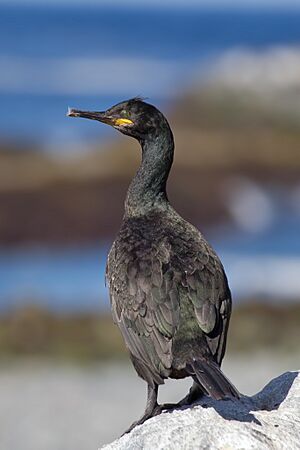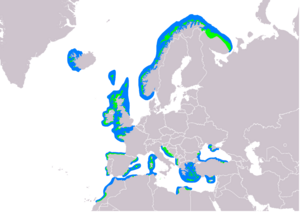European shag facts for kids
Quick facts for kids European shag |
|
|---|---|
 |
|
| European shag on a rock | |
| Conservation status | |
| Scientific classification | |
| Genus: |
Gulosus
|
| Species: |
aristotelis
|
 |
|
| Range of G. aristotelis Breeding Non-breeding | |
| Synonyms | |
|
Phalacrocorax aristotelis |
|
The European shag (also called the common shag) is a type of cormorant. Its scientific name is Gulosus aristotelis. This bird lives along the rocky coasts of western and southern Europe, southwest Asia, and north Africa. Most European shags stay in their breeding areas even in winter. In Britain, people often just call this seabird the "shag." The scientific name Gulosus comes from a Latin word meaning "glutton." The species name aristotelis honors the famous Greek philosopher Aristotle.
Contents
Understanding the European Shag
How Scientists Classify the Shag
The European shag was once grouped with other cormorants in the genus Phalacrocorax. However, a study in 2014 showed that it was quite different from those birds. Scientists then decided to give it its own genus, Gulosus. The IOC agreed with this change in 2021. Scientists believe Gulosus separated from other cormorant groups about 9 to 11 million years ago.
Different Types of European Shags
There are three main types, or subspecies, of the European shag:
- G. a. aristotelis – This type is found along the Atlantic coasts of northwestern Europe.
- G. a. desmarestii – This type lives in southern Europe, southwest Asia, and along the Mediterranean and Black Sea coasts.
- G. a. riggenbachi – This type is found along the northwest African coast.
These subspecies have small differences, like the size of their beaks or the color of their young birds' chests and legs. Some recent studies suggest that shags on the Atlantic coast of southwest Europe might be a fourth, new subspecies.
The name "shag" is also used for several other types of cormorants in the Southern Hemisphere.
What Does a European Shag Look Like?
This is a medium-sized black bird. It is about 68 to 78 centimeters (27 to 31 inches) long. Its wingspan can be 95 to 110 centimeters (37 to 43 inches) wide. It has a long tail and a yellow patch on its throat. Adult shags grow a small crest (a tuft of feathers) on their heads during the breeding season.
You can tell a European shag apart from a great cormorant in a few ways. Shags are smaller and have a lighter body. Their beaks are thinner. Breeding adult shags have a crest and their feathers have a shiny metallic green color. This green shine is why it is sometimes called the green cormorant. A shag's tail has 12 feathers, while a great cormorant's tail has 14.
European Shag Behavior and Life
Where They Find Food
European shags mostly feed in the sea. Unlike great cormorants, they are rarely seen inland. They will spend the winter along any coast that has plenty of fish.
The European shag is one of the deepest divers in the cormorant family. They have been recorded diving up to 61 meters (200 feet) deep! They usually find their food on the sea bottom, which is called benthic zone feeding. They eat many kinds of fish, but their favorite food is the sand eel. Shags often fly many kilometers from where they rest to find food.
When diving in UK coastal waters, shags usually stay underwater for about 20 to 45 seconds. They then rest for about 15 seconds between dives. This short rest helps them get enough oxygen from their lungs and bloodstream. Before they dive, they often jump out of the water to get extra speed.
Reproduction and Nesting
European shags build their nests on rocky ledges, in cracks, or in small caves along the coast. Their nests are messy piles of old seaweed or twigs. These materials are held together by the bird's own guano (droppings).
The nesting season is long. It starts in late February, but some shags don't begin building their nests until May or even later. They usually lay three eggs. When the chicks hatch, they have no downy feathers. This means they depend completely on their parents to keep them warm. They need their parents' warmth for about two months before they can fly. Young shags can start flying anytime from early June to late August, and sometimes even as late as mid-October.
What European Shags Eat
The shag is a seabird that dives to catch its food. It mainly eats fish and other creatures found on the seafloor. Scientists often study what shags eat because it's easy to collect their food samples. Also, people sometimes worry that cormorants might compete with fishing.
Studies at one colony in Scotland showed that what shag chicks eat has changed over time. This might be because of ocean warming. Shags also eat fewer sandeels on windy days. This is probably because strong winds make it harder for them to fly and hunt. The diet of adult shags at this colony has also changed over the last 30 years. They used to eat mostly sandeels, but now they eat a wider variety of prey.
Where to Find European Shags
You can easily spot European shags in these places during their breeding season, from late April to mid-July:
- Saltee Islands, Ireland
- Farne Islands and Isles of Scilly, England
- Isle of May, Deerness and Fowlsheugh, Scotland
- Runde, Norway
- Iceland
- Denmark
- Faroe Islands
- Galicia, Northern Spain
- Dalmatia and Istria, Croatia
In April 2017, eight new European shags were born in Monaco. The biggest group of European shags lives in the Cíes Islands, Spain. About 2,500 pairs live there, which is 25% of all the European shags in the world!
Images for kids
-
Young European shag in Croatia









